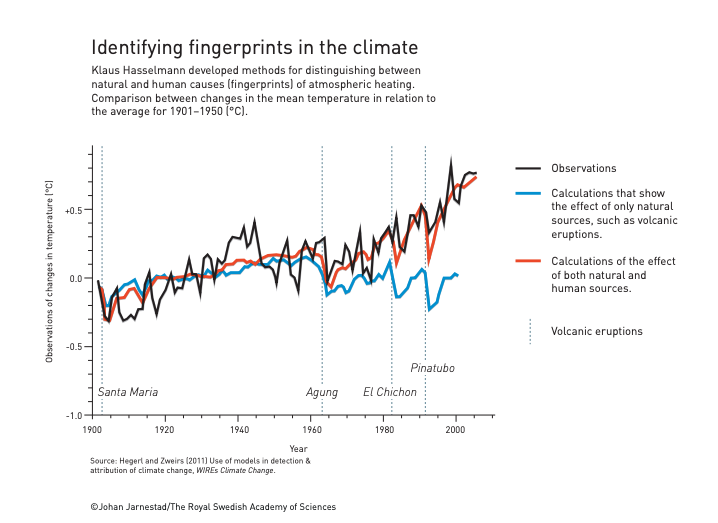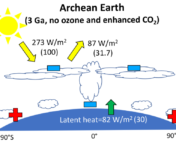Each year, we report on the astronomy and planetary science of the Nobel Prize in Physics. You can check out past coverage here. This year, as part of our climate change initiative, we’re talking about the half of the 2021 prize awarded to Syukuro Manabe and Klaus Hasselmann for their work on Earth’s climate.
Last week, the 2021 Nobel Prize in Physics was awarded to Syukuro Manabe, Klaus Hasselmann, and Giorgio Parisi “for groundbreaking contributions to our understanding of physical systems.” This technical language, though, doesn’t really capture the big statement made by this year’s prize: climate change is happening, and humans are the cause.
In today’s Bite, we’ll be focusing on the half of the prize awarded to Manabe and Hasselmann, taking a look at some of their classic papers. Their prize-winning work laid the foundations for our modern understanding of Earth’s climate and humans’ role in it, creating the first models of Earth’s climate and discovering markers of our influence on the planet. Parisi’s half focused on complex and disordered systems, concepts relevant to many disciplines including climate.
“When asked about the link between the two winning prizes, the Nobel Committee emphasized that without the ability to analyze the chaos of fluctuations/disorder, we cannot predict the changes in the climate, and they are sending a message to world leaders to act now on climate change,” wrote the American Institute of Physics.
-

Syukuro Manabe, circa 1980 -

Klaus Hasselmann, 1964
Some Climate Fundamentals
In the past decades, we’ve seen evidence that Earth’s climate is changing. Temperatures have increased, sea levels have risen, glaciers have melted, weather events (like hurricanes) have become more extreme, and more. Although there are natural processes that change Earth’s temperature (like volcanic eruptions), the drastic changes in the last century can only be explained by accounting for human activity.
The Greenhouse Effect, known as the villain of climate change, is actually vital to life. Greenhouse gases produced by natural processes—like carbon dioxide, methane, and nitrous oxide—trap the Sun’s energy and cause the planet’s temperature to rise, keeping our planet warm enough for humans to live. However, humans have been emitting greenhouse gases into the atmosphere in large quantities since the start of the Industrial Revolution, throwing off the balance and causing our current climate crisis.
Climate change poses great threats to humans, especially the most marginalized and vulnerable populations. Hurricanes will become more frequent and more destructive, higher summer temperatures lead to heat-related illnesses, and so much more. There is abundant evidence that human-made climate change exists, will affect us, and can be mitigated with prompt action—and it all started with Manabe and Hasselmann’s fundamental discoveries.

Manabe’s Models
Manabe, a Senior Meteorologist at Princeton, won a quarter of the Nobel for his work demonstrating that increasing carbon dioxide leads to increasing surface temperatures on Earth. He also pioneered models of Earth’s climate, which laid the foundation for current climate models.
Climate models are based on fundamental equations from physics and chemistry, explaining how heat is transferred and how air moves in the atmosphere. Although Arrhenius had made simple models of the atmosphere (considering incoming and outgoing radiation only) many years earlier, Manabe took a major step by incorporating water vapor and the convection of air in his models.
In the paper Manabe and Wetherald 1967, the authors used a one-dimensional model to show the clear influence of carbon dioxide (CO2) on Earth’s atmosphere and surface temperature. They found that doubling the amount of CO2 would increase surface temperatures by 2℃, while cooling the upper atmosphere. This provided a useful way to determine whether CO2 or solar radiation were causing warming with observations, because solar radiation alone would warm the whole atmosphere uniformly. These models also showed that increasing the amount of water vapor in the atmosphere would raise temperatures. They later expanded this work to more complex 3D global climate models in 1975, again finding similar trends with increasing CO2.

Hasselmann’s Fingerprints
Hasselmann, a Professor at the Max Planck Institute for Meteorology, answered the critical question of why climate models are reliable while weather is highly variable. In his 1976 study, Hasselmann incorporated chance into a climate model for the first time, accounting for the inherent randomness and variability of weather. This statistical model showed that weather can be thought of as “noise” on the larger trends of climate.
He also identified how to determine “fingerprints” of both natural phenomena and human activities, which have since been used to show that climate change is due to human influence. In this later 1993 study, building on his prior work describing the climate with statistics, Hasselmann created a method to distinguish “signals” of climate change from weather “noise.”

This year’s prize cements the recognition of climate change as supported by scientific evidence and consensus, and serves as yet another push for governments to begin taking concrete steps to address the climate crisis. The science is settled—what we really need now is action.
Astrobite edited by: Ishan Mishra and Huei Sears
Featured image credit: Royal Swedish Academy of Sciences / Niklas Elmehed




